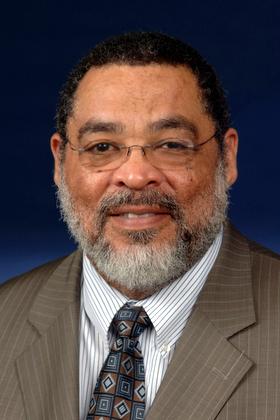
Dr. Ernest McDuffie, director, National Initiative for Cybersecurity Education
Dr. Ernest McDuffie leads federal initiative that spans personal ‘cyber hygiene’ to professional development
In a world increasingly dependent upon interconnected computer systems, cybersecurity cannot be ignored. Dr. Ernest McDuffie directs the National Initiative for Cybersecurity Education (NICE), a federal program with a portfolio that ranges from teaching people how to protect themselves on the Internet to preparing people for careers as cybersecurity professionals. Last month, he was keynote speaker for the 12th annual NOAA-CREST Day at The City College of New York.
Four areas – national awareness, formal education, workforce development, training and professionalization – comprise NICE’s agenda. While Dr. McDuffie says 80 percent of his work involves outreach to business, state and local governments, education and consumers, it also coordinates activities across more than 20 different government agencies.
Public awareness is of paramount importance to national security and prosperity, Dr. McDuffie points out, and society’s dependence upon the Internet heightens that importance. “The Internet was not built with security in mind. It has all sorts of vulnerabilities, and large computer systems are vulnerable, too, whether they are connected to the Internet or not,” he says.
Further, he notes, “People are the weakest link in computer systems.” To address the human issue, NICE promotes “cyber hygiene,” educating people about security procedures that the public can follow to protect themselves against identity theft, bullying on social media sites and other cyber menaces. One of the program’s goals is to expand the Department of Homeland Security’s Cybersecurity Month into a year-round agenda of activities.
NICE’s formal education agenda involves curriculum development initiatives that span from kindergarten to post-graduate education. They are run by the U.S. Department of Homeland Security and the National Science Foundation. “This is a young and rapidly evolving field and people need to be lifelong learners,” Dr. McDuffie says. One of the education initiatives involves the support of cyber competitions at all levels.
The Department of Homeland Security is also working with the National Academies to professionalize the field. Dr. McDuffie compares the effort to what medicine went through in the early 20th century.
“We want people to talk about cybersecurity in common language across agencies and establish a national cybersecurity workforce framework for people in the private sector,” he explains. One of the initiatives involves certifying companies, contractors and academic institutions as centers of excellence.
The NICE program has been well received by the information technology industry, Dr. McDuffie adds. “People look to us (federal government) for leadership. We’re a huge consumer, and where we go the market follows.”
He added that technology companies have the same workforce issues as the federal government, noting that cybersecurity represents a growth area for job-seekers. The Department of Defense, which is the biggest employer, is looking to hire 4,000 cybersecurity professionals in the near future. Other potential opportunities may be found in energy as the nation moves toward a smart grid infrastructure and in healthcare due to the need to secure electronic medical records.
“These are good jobs that are attractive to young people,” Dr. McDuffie says. While demand is strongest for people with computer science, computer engineering and math backgrounds, people with liberal arts backgrounds and strong communications skills are needed, as well.
On the Internet
MEDIA CONTACT
Ellis Simon
p: 212.650.6460
e:
esimon@ccny.cuny.edu